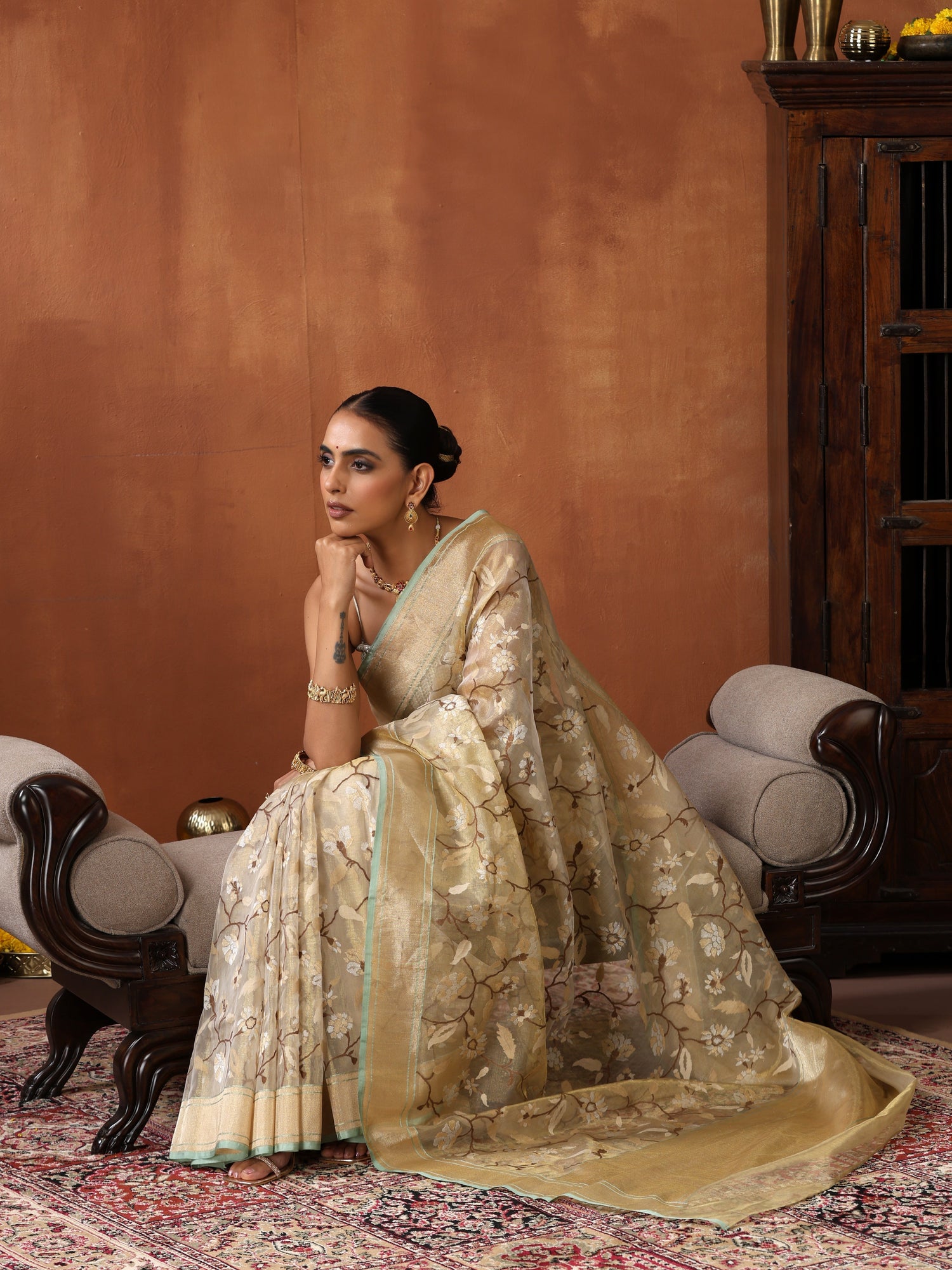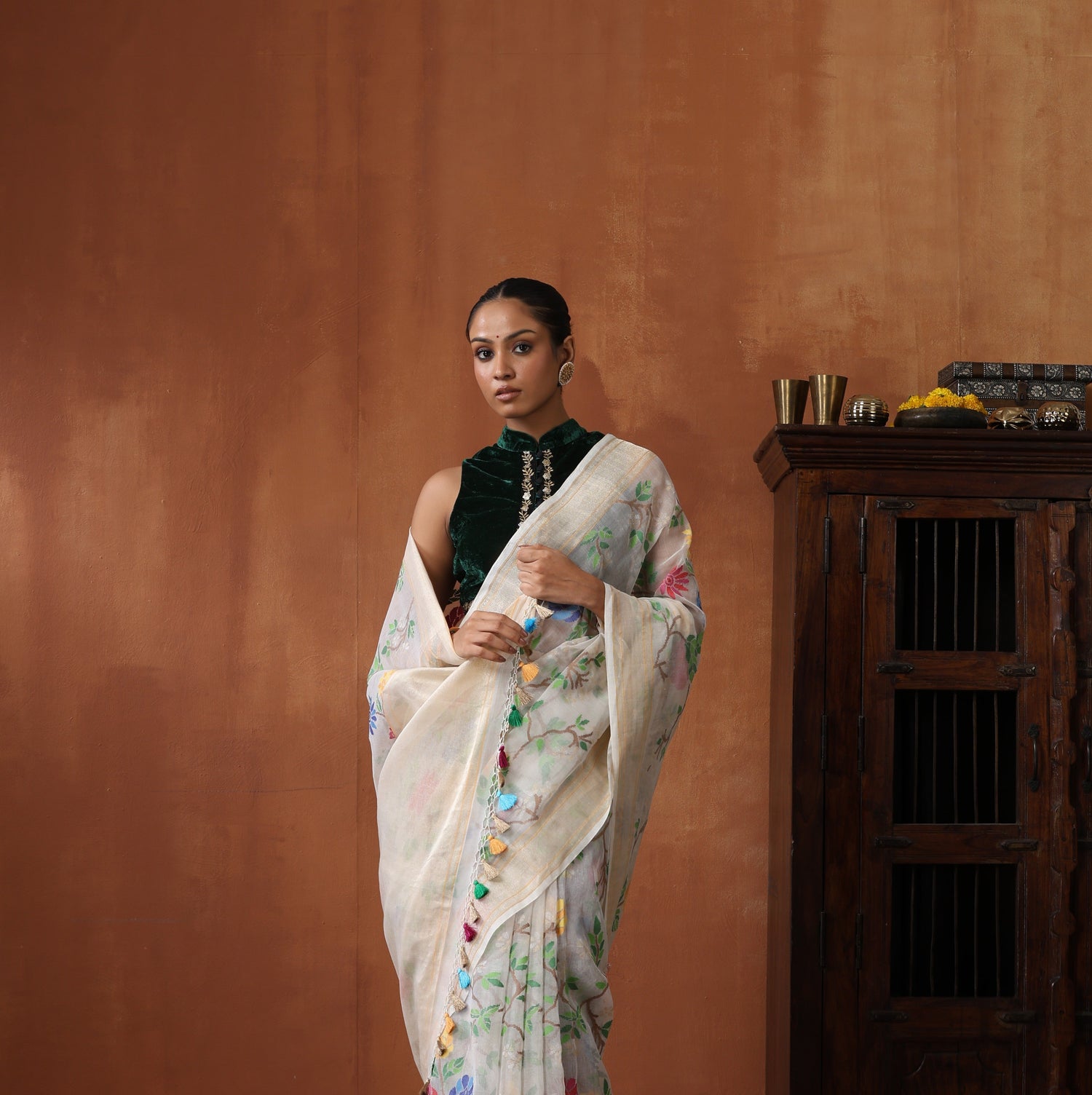If you ask out of so many exquisite Banarasi silk saris, which is that one silk which holds a special place in silk which oozes royalty and elegance to your closet? The answer is the one and only TANCHOI!
Light, soft and yet rich because of its embossed weaves and motifs, the intricate patterns on the Tanchoi make each piece, a work of art. But apart from its sheer beauty, the Tanchoi brocade is also a stand-out because of the story attached to it and the journey it made across the continent.So are you readers excited to read the story of Tanchoi silk today in our blog?
The Origin and History of the Tanchoi Silks
While Tanchoi is closely connected to Banaras and its rich tradition of silk weaving, this fabulous silk traces its roots to China. It is said to have made its way to India thanks to Parsi traders who loved their silk!The story of Tanchoi starts in the mid 19th century CE. It is believed that Sir Jamsetjee Jejeebhoy, a Parsi merchant commissioned three weavers from a Joshi family of Surat, to travel to China and learn the craft of weaving this particular brocade silk, around 1856 CE. Once they returned, the brothers adopted the name of their Chinese teacher, Chhoi, who had taught them the art of silk weaving. Tan, close to the Gujarati word tran meaning ‘three’, referred to the three brothers. Hence the silk they learned to make, came to be known as the Tanchoi
Unfortunately, by the early 20th century, European fashion took over in the port city of Bombay and this silk was replaced by Georgette and lighter fabrics. The production of Tanchoi sarees went on till the 1950s in Bombay. The twist in the story came up then that the Banaras weavers learned the art of making these brocades and started producing the same fabric, for a much cheaper price. This is also how some of the intricate Banarasi designs made their way onto Tanchoi silks.Today, Tanchoi saris are back in the limelight and hugely popular across India. But few who buy it, notice the threads of history that created this rich fabric or how the ancient city of Banaras embraced the Tanchoi, making it its own!
Weaving process
Tanchoi is one of the weaving techniques involving a single or double warp and two to five colors on the weft which are often of the same shade. Another stand-alone feature of the Tanchoi sarees is that the fabric texture background has a Satin finish. It is one of the complex and technical weaving techniques as it uses one or two warp and two to five weft colors. These sarees are extremely lightweight and soft to drape.
Varieties of Tanchoi
Banarasi Tanchoi has several different varieties:
- Satin Tanchoi – As the name suggests, it is based on a Satin fabric base of a single color and the weft threads of one or more colors. The additional weft colors can also be used as a body weft.
- Satin Jari Tanchoi – This is an extension of Satin Tanchoi wherein the weft is a combination of either one Silk and one Gold thread or two Silk threads and one Gold thread.
- Atlas or Gilt – The fabric surface is pure satin. In comparison to other fabrics, Atlas or Gilt is heavier and has more shine because of the extra use of zari.
- Mushabbar – This version stands out with its net woven design to appear as bushes or branches of a tree. The Mushabbar design is often associated with a jungle or nature’s greenery
Colors and Patterns
Tanchoi textiles are fabricated in vibrant colors and the weaving technique employs several silk yarns. Like Brocades, Tanchoi is also constructed using an extra set of colorful weft silk yarn covering the satin ground thus creating unusually distinctive patterns.In Tanchoi sarees, the designs are always figures of flying birds, paired cocks amidst floral sprays, which are worked all over the body surrounded by flowers and baskets containing flowers. Sometimes the pallu is done more solidly with peacocks, baskets or bunches of flowers or hunting scenes. Tanchoi silk sarees are also ornamented in some ravishing floral, geometrical and paisley designs. Most of the times the designs are of Chinese origin but weavers also integrate Indian motifs to create unique pieces of art.
Tanchoi in Current Days
Did you know that our Prime Minister Narendra Modi, on a visit to the United Kingdom in 2015, presented a Tanchoi stole to Queen Elizabeth II?
Tanchoi sarees are popular across the country for formal occasions, wedding ceremonies or festivals. Tanchoi Silk Sarees are ideally worn in cooler months of autumn and winter owing to the fabric.
Check out some of the Khinkhwab Tanchoi Products which would be some ravishing additions to your ethnic closet!
Brown Pure Katan Silk Handloom Tanchoi Banarasi Saree
Ooh-la-la! Check out this exclusive Katan Silk range of Tanchoi weave by Khinkhwab, that is sure to make you fall in love with!

Green Handloom Banarasi Katan Silk Tanchoi Saree
Check out this beautiful Katan Silk Saree with both sides of Tanchoi, that is woven with pure Resham threads, which is a perfect wear for any weddings!

Sindoori Katan Silk Tanchoi Handloom Banarasi Saree
Khinkhwab brings you an exclusive Katan Silk Tanchoi Jamewar saree with paisley woven all over, inspired by Kashmiri designs.

Pink Katan Silk Tanchoi Handloom Banarasi Saree

Khinkhwab Tanchoi Sarees ranges in the price starting from Rs. 20,000/-. Have a look at this and you will find it definitely worth!
If you are looking at supporting handmade and buy Handloom Banarasi silk attires online, you can find them all in this one-stop-shop Khinkhwab - The Essence of Banaras
Like and follow us on Social media: Facebook | Instagram | Twitter | Pinterest




